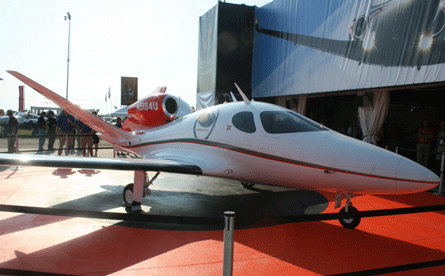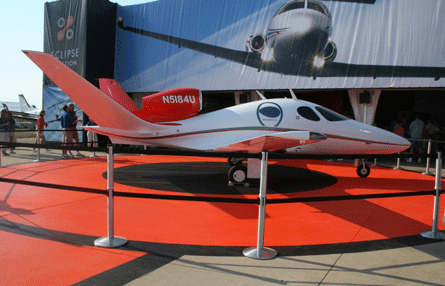The company that introduced the first very light jet has disclosed today developing an even lighter, single-engine aircraft currently called the Eclipse Concept Jet (ECJ).
The Pratt & Whitney Canada PW615F is mounted externally above and behind the fuselage, with exhaust flowing over a V-tail.

Unveiling the prototype at the week-long EAA Airventure in
The ECJ, which first flew 2 July, is estimated to cruise at a top speed of 345 knots and its service ceiling will be 41,000 feet, yet needs no more than 2,200 feet of runway to take off or land. The aircraft’s range is estimated to be 1,250 nautical miles.

The new aircraft has accumulated just under 30 flight hours at speeds up to 250 knots and altitudes up to 25,000 feet
“While today we have no production plans for the ECJ, we are constantly evaluating markets for future Eclipse products,” says Vern Raburn, president and CEO. “We are anxious to reveal the potential of this emerging category.”

The engine mounting and V-tail configuration resembles the jet mock-up unveiled by Cirrus June 27. Computer controls and improved design capability make V-tails more feasible than when they were first used, says Raburn.
“We know about yaw dampeners today, which the original Bonanza did not have,” he adds.

The personal jet class brings speed to runways as short as 2,200 feet. “We have seen the last of $2 per gallon of Jet A,” Raburn adds, “It’s an absolute reality that we are moving into a new era, and we think fuel efficiency is important.”
The ECJ also features Eclipse’s Avio NG system. The all-electric ECJ design delivers full Avio NG functionality, including aircraft computer systems, flight control trims, autopilot, electrical power distribution, FADEC, air data, AHRS, landing gear and flap actuation.
Leveraging Avio NG’s Total Aircraft Integration™, all of the ECJ’s major system components are controlled and managed using Avio NG – exactly as they are on the Eclipse 500.
Swift Engineering of San Clemente, California was contracted to assist with the design and build the ECJ in slightly over six months.
“Swift Engineering has been a tremendous partner, and was instrumental in taking this new aircraft from design to flight test so rapidly,” says Raburn.
The aircraft’s registration number – N5184U – is registered by Swift Engineering, not Eclipse, as the “Mark 400” model, according to the US FAA web site.
Source: FlightGlobal.com























